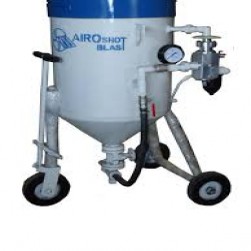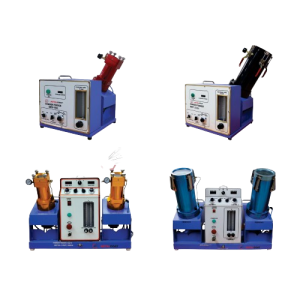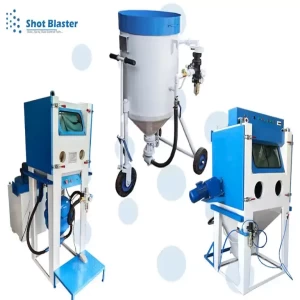Q. What is sand blasting?
Search
All Categories & Products

Portable Sand Blasting Machine in Bangladesh
The portable sandblasting machine is an advanced version of the sandblasting machine. It has portable wheels by which it can move from one job site to another easily.

|
Portable sandblasting machine WITH REMOTE |
Portable sandblasting machine WITHOUT REMOTE |
| Can be operated by remote | Cannot be operated by remote |
| A single operator is sufficient | More than one operator is needed |
| Simple operation | Quite complicated operation |
| Expensive | Cheaper |
| MODEL | PRESSURE TANK THICKNESS | CAPACITY | NOZZLE SIZE | CLEANING RATE |
| P7-150 | 6 mm | 150 kg | 5 mm | 3 to 4 m2/hr. |
| P7-300 | 6 mm | 300 kg | 6 mm | 5 to 7 m2/hr. |
| P7-500 | 6 mm | 500 kg | 8 mm | 9 to 12 m2/hr. |
| P7-1000 | 6 mm | 1000 kg | 10 mm | 15 to 21 m2/hr. |
A portable sandblasting machine is a type of sand blasting machine which have additional features of movable wheels and handle which make it convenient to move it from one job-site to another at any location easily. In a portable sandblasting machine, any type of abrasive material can be used for blasting purposes. This machine is used in many industries for removing dust, contaminants, and anti-corrosion coatings from metal surfaces. It is also used for surface preparation before painting, welding, or applying any other coatings. Portable sandblasting machines are available in a wide range of models. They have different sizes and specifications depending on the applications for which they are being used.
Main parts of portable Sand Blasting machine
- WHEELS: Wheels are used to move the machine from one place to another.
- HANDLE: The handle of the portable sandblasting machine makes it convenient to carry the machine at any job-site.
- COMPRESSOR: The compressor plays an important role in the sandblasting machine. The pressure through which air and abrasive media will fall out on the metal surface for blasting depends on the compressor. Higher will be the pressure, more will be the velocity of the abrasive media through which it falls on the surface and by this excellent blasting can be done.
- HOSE COLLAR: The compressed air released from the compressor goes into the machine with the help of a hose collar.
- AIR-FILTER: When the compressed air enters the machine, it carries some amount of moisture with it. This moisture may damage the machine parts, so it is very necessary to separate that moisture from the compressed air. For this, an air filter is used which helps in separating the moisture from the compressed air and through which moisture-free air passes through NRV.
- NRV (Non-Returning Valve): NRV helps in blocking the flow of air. When compressed air passes through the NRV it cannot come back from its directed way and go to the blasting hose.
- PRESSURE GAUGE: The pressure measurement can be done with the help of a pressure gauge. It shows the exact reading of the pressure in kg/cm2 as well as in-lb/inch.
- T joint: After passing through the NRV the compressed cannot return, so it goes to the pressure pot the T joint.
- BALL VALVE: When the ball valve is released, the compressed air passes through the blast hose to the mixing tube.
- BLASTING HOSE: With the help of a blasting hose, the compressed air move to the mixing tube, where it mixing of abrasives and compressed air takes place.
- PRESSURE POT: A pressure pot is a container that contains the abrasive media and the compressed air. It maintains the required pressure for blasting.
- Mushroom valve: The mushroom valve is also known as the ‘Pop up valve’. It is capable of its own movement. The mushroom valve is used for automatic tank sealing purposes. When compressed air comes in the pressure pot, it automatically seals the pot and thus maintains pressure. Also, when the blasting is done, it depressurizes the tank and facilitates refilling.
- MIXING TUBE: When the compressed air from the blasting hose moves in the mixing tube, abrasive from the pressure pot also enters simultaneously, and mixing of both abrasive media and compressed air takes place in the mixing tube.
- PINCH VALVE: When the pinch valve is released, it allows the abrasive media to enter into the mixing tube. The pinch valve is fitted at the mixing tube with the help of a pinch valve plate mounted on the rubber sleeve.
- UNION: The union work as a jointer through which the hose connector and nozzle holder are connected with the machine.
- RELEASE VALVE: Release valve is used to depressurize the pressure pot when the whole blasting operation is stopped.
- NOZZLE: Nozzle is fitted with the nozzle holder at the blasting hose where a rubber ring is used so that it can be protected from the abrasive media when it passes through it. It is generally made up of tungsten carbide.
- REMOTE CONTROL SYSTEM: It is a complete pneumatic control system for remote activation and deactivation of the abrasive blast pot. The remote control system mainly consists of a remote control valve and a dead manhandle.
- DEAD MAN HANDLE: When the dead man handle is activated, the blasting process begins. When the handle is released the blast cleaning process stops and the system exhaust air from the vessel to allow for filling of more abrasive to the blast cleaning pot.
Principle of the portable sand blasting machine
In a portable sandblasting machine, abrasive media is propelled out with compressed air at a very high velocity and pressure at the metal surface which needs to be re-engineered through blasting. With that high-pressure, media falls on the substrate and removes all the dust particles and contaminants, and gives a smooth surface. Here, the compressor plays a very important role in blasting. The blasting rate of the machine depends on the pressure provided by the compressor to the air and abrasive media.
Working of portable sand blasting machine
In a portable Sand Blasting machine, abrasive media is put into the pressure pot through a girt mesh. On the other hand, compressed air enters through the hose collar at a very high velocity and pressure. When the ball valve is released, the compressed air passes through the air filter. The compressed air contains some moisture with it, so it became necessary to separate the compressed air from the moisture. For this air-filter is used, it separates the moisture from the air and allows it to pass to the blasting hose through NRV. NRV blocks the flow of air to return and directs its way. The ball valve is released so that air can be passed to the blasting hose from which it enters the mixing tube. When the abrasive enters in the pressure pot, the mushroom valve activates and seals the pressure tank automatically. Abrasive media and compressed air from the pressure pot goes to the mixing tube. At the mixing tube, both air pressure and the abrasive-compressed air pressure met. Here, with the high pressure and velocity, the abrasive media and compressed air propelled out at the metal surface and blasting is done.
Types of portable sand blasting machine
Mainly portable sandblasting can be classified into two categories based on its mechanism. Such as:
- Portable sand blasting machine WITHOUT REMOTE
- Portable sand blasting machine WITH REMOTE
They have similar working but their mechanism is quite different. In a portable sandblasting machine without a remote, remote system is not used whereas; in a portable sandblasting machine with the remote, remote system is used. Both machines have different specifications and are used for different applications.
Portable sandblasting machine WITHOUT REMOTE
A portable sandblasting machine without a remote is a conventional machine used for sandblasting. It does not have a remote control system in it. Without a remote system, the abrasive and compressed air is propelled out on the metal surface and the blasting process is carried out normally. Here, more than one operator is needed to START/STOP the blasting process. An extra operator is required to deactivate the release valve so that the pressure pot can be depressurized and refilling of abrasive media can be done for another blasting process.
Portable sandblasting machine WITH REMOTE
A portable sandblasting machine with a remote is an advanced version of the sandblasting machine. It has a remote control system and can be operated by that remote. More operators are not required in operating this machine. A single operator can also deactivate the release valve with the help of a switch which is connected with the remote control system. With the help of a switch, the operator can deactivate the machine from the place where he is doing the blasting.
Models of Portable sandblasting machine
Based on different sizes and specifications, portable sandblaster machines are available in different models. The selection of models depends on the application for which they are being used.
Some standard models of the portable sandblasting machine are:
- P7-150
- P7-300
- P7-500
- P7-1000
On special demands, P7-750 is also available.
Portable sandblasting machine Price in India
Dustless blasting machine manufacturing company manufactures and supplies a number of blasting machines and products. A portable sand blasting machine with or without remote both is available here at a very low price. Along with that sand blasting machine, shot blasting machine, abrasive media, dust collector are also available at affordable prices.
Ans.
Sand blasting is the activity of coercively impelling a surge of abrasive material against a surface constrained to smooth an unpleasant surface, roughen a smooth surface and shape a surface, or eliminate the surface pollutants. Sand used to be the most usually utilized material, however since the lung infection silicosis is brought about by broadened inward breath of the residue made by sand, different materials are currently utilized in their place.
Q. What is difference between shot blasting and sand blasting?
Ans.
Sand blasting and shot blasting both are the cycle which is being used in mechanical surface cleaning. Many industries that utilization metal applies these techniques in everyday rehearses for eliminating consumption, paint, and different movies and setting up the surface for covering. In the two techniques, cast ironwork is additionally impacted to eliminate old paint layers. In any case, the contrasts between the two cycles are just for rule and application types.
Q. Why Sand blasting is done?
Ans.
The main purpose behind sand blasting is to eliminate paint or rust and other surface-toxins from hardware, vehicles, houses, and practically some other surface. In the interim, it is a surface treatment measure broadly utilized in a wide range of enterprises for different purposes.
Q. What is the use of Sand blasting?
Ans.
To remove paint or rust from the surface Sand blasting is highly recommend. This cycle is coercively impelling a surge of grating material against a surface constrained to smooth or unpleasant the surface. Sand blasting can prompt the paint to look lopsided when it fixes and bubbles once the task gets wrapped up.
Q. What is a Sandblaster job?
Ans.
The sandblaster works to clean and scrape a surface, regularly metal, of any rust, paint, or other undesirable surface materials. In this innovation, the hose associates with the air tank, and the hopper is loaded up with a grating to guarantee the best outcomes with no obstacles.

